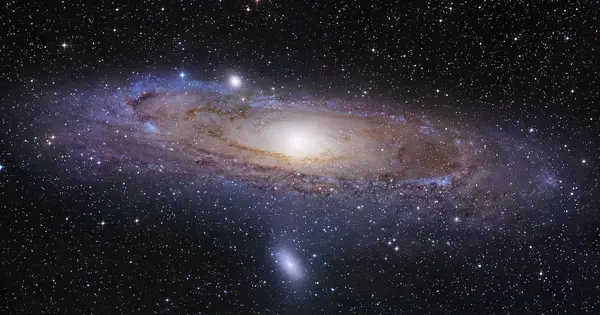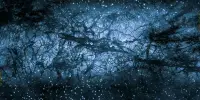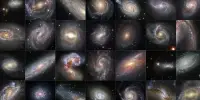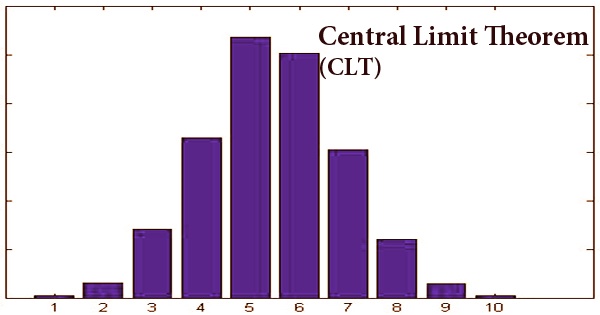Andromeda Galaxy, also known as the Andromeda Nebula, is the nearest large galaxy in the constellation Andromeda. The Andromeda Galaxy is one of the few that can be seen without a telescope, appearing as a milky blur. It is about 2,480,000 light-years from Earth, has a diameter of about 200,000 light-years, and shares many characteristics with the Milky Way system.
A careful examination of the composition and motion of over 500 stars revealed conclusive evidence of an ancient collision between Andromeda and a neighboring galaxy. The findings, which improve our understanding of the events that shape galaxy evolution, were presented Monday at the American Astronomical Society meeting by Carnegie’s Ivanna Escala.
The Andromeda Galaxy is approximately ten billion years old. The Milky Way Galaxy, on the other hand, is approximately 13.6 billion years old. Andromeda, like most other galaxies, grew through a series of collisions with smaller protogalaxies and subsequent mergers with larger ones. The Milky Way is currently devouring at least one dwarf galaxy and forming through mergers.
Our findings are consistent with modeling predictions that the Giant Stellar Stream is the first material loop from a collision and the NE shelf is the second layer wrap-around. This level of analysis confirms previous predictions about Andromeda’s violent past and contributes to astronomers’ understanding of how material accreted by collisions shapes a galaxy’s surrounding features and evolutionary history.
Ivanna Escala
Galaxies grow by absorbing material from nearby objects, such as other galaxies and dense clumps of stars known as globular clusters, which occur frequently in the aftermath of a catastrophic collision. And these events leave behind relics in the form of stellar associations known as tidal features by astronomers. This can take the form of elongated streams or arcing shells moving around the surviving galaxy. Studying these phenomena can help us understand a galaxy’s history and the forces that shaped its appearance and makeup.
“The remnants of each crash can be identified by studying the movement of the stars and their chemical compositions. Together this information serves as a kind of fingerprint that identifies stars that joined a galaxy in a collision,” Escala explained.
She and her collaborators — Karoline Gilbert and Mark Fardal of the Space Telescope Science Institute, Puragra Guhathakurta of UC Santa Cruz, Robyn Sanderson of the University of Pennsylvania, Jason Kalirai of Johns Hopkins Applied Physics Laboratory, and Bahram Mobasher of UC Riverside — studied 556 red giant branch stars in a physical feature of Andromeda called the Northeast shelf, which forms a sharp ledge in the density of the galaxy’s material.
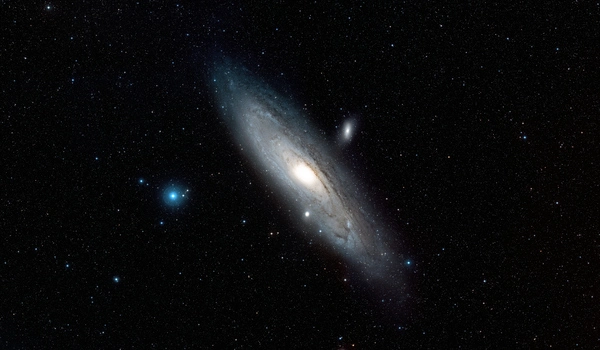
“We performed the first detailed characterization of the chemical composition and geometric motion of the stars in this region of our neighboring galaxy, demonstrating conclusively that the NE shelf is a tidal shell predominately composed of debris from a collision,” Escala explained.
Their research also shows that the NE shelf is part of a multi-shell system with the galaxy’s West and Southeast shelves, and that the material in these regions is consistent with that of Andromeda’s Giant Stellar Stream, implying that all of these tidal features may have originated from the same source.
“Our findings are consistent with modeling predictions that the Giant Stellar Stream is the first material loop from a collision and the NE shelf is the second layer wrap-around,” Escala concluded. This level of analysis confirms previous predictions about Andromeda’s violent past and contributes to astronomers’ understanding of how material accreted by collisions shapes a galaxy’s surrounding features and evolutionary history.
For centuries, astronomers considered the Andromeda Galaxy to be a component of the Milky Way Galaxy, i.e., a spiral nebula similar to other glowing masses of gas in the local galactic system (hence the misnomer Andromeda Nebula). Only in the 1920s did American astronomer Edwin Powell Hubble establish conclusively that the Andromeda galaxy existed independently of the Milky Way.
The Andromeda Galaxy has a history that includes collisions with and accretion of other galaxies. It’s strange close companion, M32, has a structure that suggests it was once a normal, more massive galaxy that lost much of its outer parts and possibly all of its globular clusters to M31 in a previous encounter. Deep surveys of the Andromeda Galaxy’s outer parts have revealed massive coherent structures of star streams and clouds, with properties indicating that these include the outer remnants of smaller galaxies “eaten” by the giant central galaxy, as well as clouds of M31 stars ejected by the collision’s strong tidal forces.
